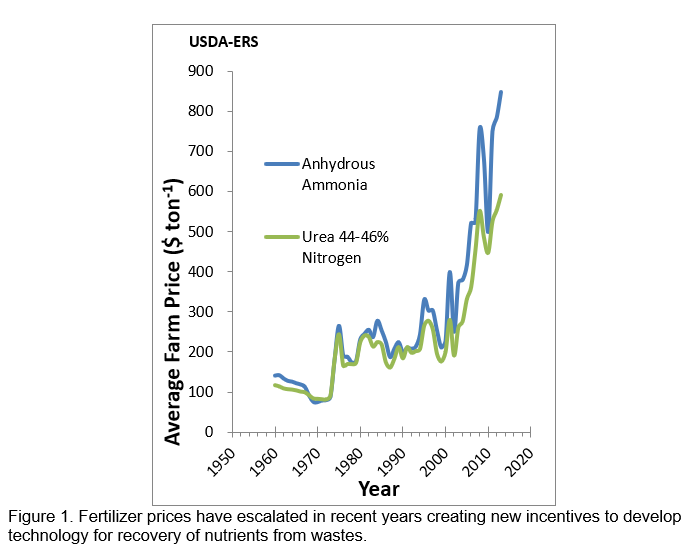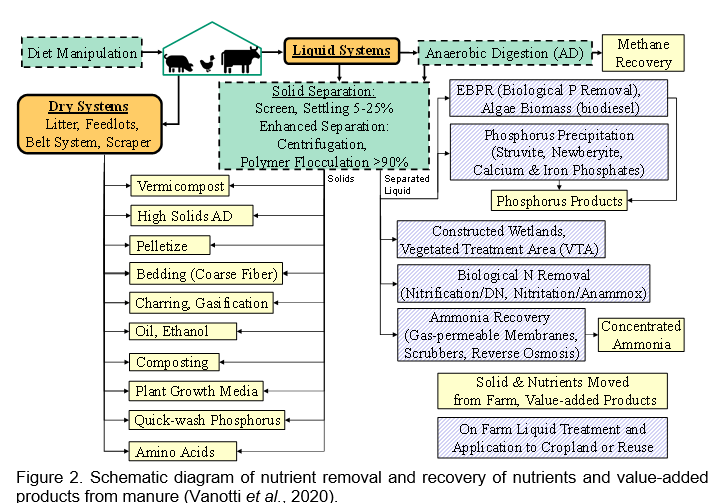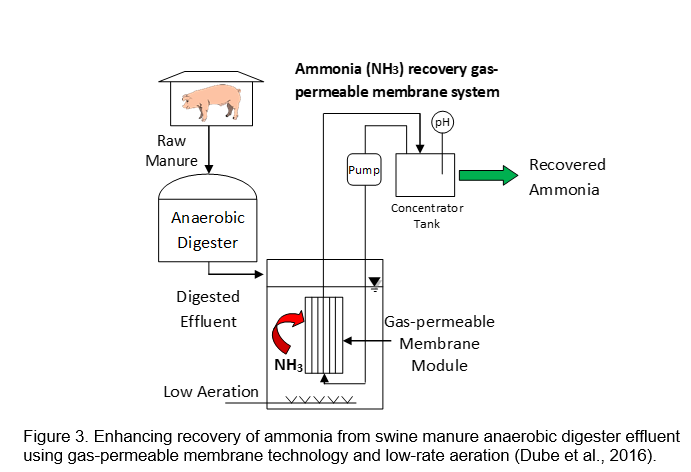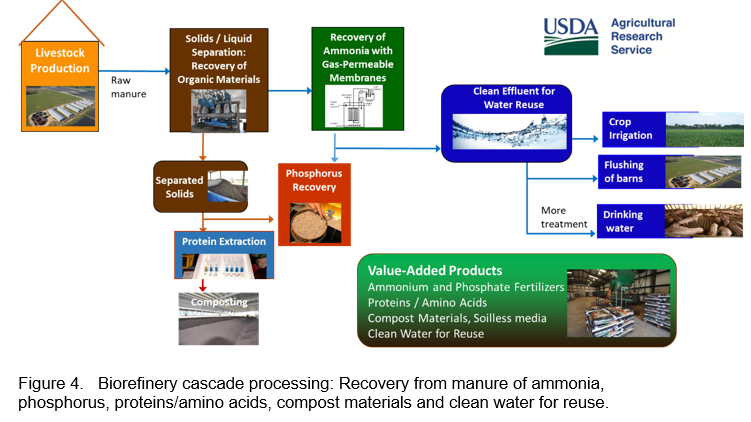ABSTRACT
Many areas in the world produce more manure nutrients than available cropland can assimilate due to agglomeration of livestock production. Development of technologies for nutrient reuse was identified as one of the five main challenges in waste management within a circular economy. More sustainable techniques using P recovery for both solid and liquid waste are important to close the P cycle loop in both livestock agriculture and municipal sewage systems and address future P scarcity. Fertilizer prices have escalated in recent years. Circular economy in agriculture is a way of agricultural production that benefits with inputs from recycling or renewable sources. Animal manures contain many valuable materials such as ammonia, phosphorus, proteins/amino acids, compost materials and clean water for reuse that could be extracted, recovered and reused in a circular agriculture. The recycle and reuse of agricultural residues and concentrated products could make the most efficient use of natural sources, close the loop in nutrient cycling, and bring new income to farmers.
Keywords: Nutrient Recovery, Nutrient Re-Use, Upcycling, Waste, Manure, Organic Fertilizers, Sustainability, Concentration of Nutrients, Value-Added Products, Circular Economy
NEED FOR CIRCULAR ECONOMY APPROACH IN LIVESTOCK RESIDUES
Environmental and policy issues associated with swine production are specific for each region; however, regardless of location, these issues generally include land application of manure and potential discharge of manure nutrients (nitrogen and phosphorus) and pathogenic bacteria to surface and groundwater; and aerial emissions of ammonia, methane, pathogens and odor. Once dominated by many small operations as part of traditional crop-livestock farms, livestock production has become highly concentrated in large operations. This development has separated animal production from crop production. Thus, the amount of manure produced often exceeds local demand for use as fertilizer.
Many areas in the world produce more manure nutrients than available cropland can assimilate. In the U.S., among all nutrients in manure, nitrogen (N) and phosphorus (P) cause the greatest environmental concern (Gollehon et al., 2016). It was estimated that 36% of the 170,000 animal feeding operations (AFO) in 2012 could not land-apply all the manure produced on the farm, resulting in farm-level excess manure containing about 868,000 metric tons of farm-level excess manure N and 388,000 metric tons of excess manure P, equal to 59% of the total recoverable manure nutrients produced on the farms (Gollehon et al., 2016). More sustainable techniques using P recovery for both solid and liquid waste are important to close the P cycle loop in both livestock agriculture and municipal sewage systems and address future P scarcity (Desmidt et al., 2015; Keyzer, 2010). Circular agriculture is a framework which aims to close the loop on agriculture.
Nitrogen is another example of the negative effects of a linear economy of take-make-consume-dispose. Nitrogen fertilizer prices have escalated in recent years (Figure 1). The largest source of ammonia (NH3) emissions in the U.S. is livestock production, contributing 2.5 million tons per year (USEPA, 2004). Thus, there is renewed interest in developing technologies to recover and recycle nutrients from manure. Development of technologies for nutrient reuse was identified as one of the five main challenges in waste management within a circular economy (Bernal, 2017). Circular economy in agriculture is a way of agricultural production that benefits with inputs from recycling or renewable sources. This recycle and reuse of agricultural residues and byproducts could not only make the most efficient use of natural sources and close the loop in nutrient cycling, but also bring added value and new income to farmers.

APPROACH TO NUTRIENT RECOVERY AND WATER REUSE
Treatment can be enhanced using biological, chemical, and physical methodologies, especially in combination or as part of holistic systems (Vanotti et al., 2009). Figure 2 illustrates alternative approaches for removing and recovering N and P from animal manure using both on-farm and off-farm management. The separation up-front in a treatment train allows recovery of the organic compounds, which can be used for the manufacture of compost materials and other value-added products or energy production. Useful products may include stabilized peat substitutes, humus, biochars, soil amendments, bio-oils, organic fertilizers, energy, quick-wash phosphorus, and proteins/amino-acids. The remaining liquid can be processed to extract concentrated P and ammonia, and regenerate water for reuse in the barn for flushing, for crop irrigation, or for drinking water for the livestock after further treatment.
Aside from cost effectiveness/affordability, desirable characteristics of the technologies are: recovers and concentrates of nutrients; produces materials with predictable nutrient concentrations; byproducts can be used directly with no need of further industrial processing other than the recovery process; ability to produce low-nutrient effluent from liquid manure stream; compatible with existing animal production facilities and manure management systems; and yields multiple additional benefits such as odor and pathogen reduction, reduce GHG, generates energy and water for on-farm reuse, and provides other ecosystem benefits such as protection and restoration of water quality and water quality credits (Vanotti, 2020).
This presentation at FFTC AP-VAAS Forum on Circular Agriculture for Sustainable Health Diets shows technologies developed at USDA-ARS addressing recovery and reuse of valuable materials from livestock waste addressing circular agriculture needs.
Enhanced solids-liquid separation
Solid-liquid separation up-front in a treatment train allows recovery of the organic compounds that can be used for manufacture of high-quality compost materials, peat substitutes, quick-wash phosphorus and biochars (Vanotti et al., 2020). The polymer flocculation and screening treatment effectively removed organic nutrients (92% P and 85% N). Natural flocculants may have an important role in waste management because of increased cost of energy and renewed interest on organic farming systems. Garcia et al. (2009) indicated that natural occurring flocculants such as chitosan can be as effective as synthetic polymers for the separation of solids and nutrients from concentrated dairy manure effluents.
Value-added proteins and composts from manure solids
Composting of animal manure should be seen as a technology that adds value, producing a high-quality product focused on specific agricultural markets such as soilless media for nursery crops, orchard mulching, and organic farming (Bernal et al., 2009). Composting of the separated manure solids can be done in a centralized facility since it is a very specialized operation to produce high-quality materials. In this facility, the manure solids are combined with carbon rich materials such as cotton gin waste to optimize the composting process and avoid N losses (Vanotti et al., 2020).
Substantial amounts of proteins and phosphorus can be extracted from swine manure; 15-17% of the dry weight were proteins and 3% recovered phosphorus. New protocols have been developed to extract proteins and phosphorus from manures. A new process uses the synergistic combination of two wastes for nutrient recovery: animal waste and fruit waste (Vanotti et al, 2020b). Manure contains abundant phosphorus and proteins, and fruit wastes provide sugars that produce the acids needed to extract the phosphorus and proteins.

Ammonia recovery
The recovery of N from wastes will be important in agriculture because of the high cost of commercial N fertilizers and the environmental damage of the release of reactive nitrogen. We developed new systems and methods that use gas-permeable membranes to recover significant amounts of ammonia when operated in: 1) liquid manure such as lagoon and raw liquid manure (Vanotti and Szogi, 2015), and 2) barns to remove the ammonia from the air (Szogi et al., 2014b). The new process includes the passage of gaseous ammonia through a micro-porous hydrophobic membrane and subsequent capture and concentration in a stripping solution on the other side of the membrane. For liquid applications, the membrane manifolds are submerged in the liquid, and the gaseous ammonia is removed from the liquid before it escapes into the air (Figure 3). For air applications, the membrane manifolds are suspended above the litter, and the gaseous ammonia is removed inside the barns close to the litter.

Phosphorus recovery
In animal manures, the presence of bicarbonate is an interference in the production of high-grade phosphates. Vanotti et al., 2005, used a biological (microbial) acidification with nitrifiers as a way to destroy carbonate alkalinity and produce high-grade phosphates from swine wastewater using an alkaline-earth metal. Another method used a chemical acidification: it adds mineral or organic acids to acidify the manure before the P precipitation step with lime (Quick Wash process, Szogi et al., 2014a). A third method to overcome the bicarbonate interference uses physical acidification: it adds the P precipitating compounds (calcium or magnesium) to the wastewater after the carbonate alkalinity and ammonia are substantially reduced using gas-permeable membranes (Vanotti et al., 2017). It was found that, when magnesium is added to wastewater with both the alkalinity and ammonia removed, the phosphates produced are very high grade (46% P2O5, >98% available), similar to the composition of the biomineral newberyite (MgHPO4.3H2O) found in guano deposits (Vanotti et al., 2017).
Biorefinery cascade processing
Animal manures contain many valuable materials such as ammonia, phosphorus, proteins/amino acids, compost materials and clean water for reuse (Figure 4), which could be reused in a circular agriculture. There is a need to develop new biorefinery cascade processing systems to extract valuable materials from manure to make the most efficient use of natural sources, to close the loop in nutrient cycling, and to bring new income to farmers.

REFERENCES
Bernal, M.P., J.A. Alburquerque, and R. Moral. 2009. Composting of animal manures and chemical criteria for compost maturity assessment. A review. Bioresour. Technol. 100:5444-5453.
Bernal, M.P. 2017. Grand challenges in waste management in agroecosystems. Frontiers in Sustainable Food Systems, https://doi.org/10.3389/fsufs.2017.00001
Desmidt, E., K. Ghyselbrecht,Y. Zhang, L. Pinoy, B. Van der Bruggen, W. Verstraete, K. Rabaey, and B. Meesschaert. 2015. Global phosphorus scarcity and full-scale P-Recovery techniques: a review. Crit. Rev. Environ. Sci. Technol. 45 (4):336-384.
Dube, P.J., M.B. Vanotti, A.A. Szogi, and M.C. García-González. 2016. Enhancing recovery of ammonia from swine manure anaerobic digester effluent using gas-permeable membrane technology. Waste Management 49:372–377.
Garcia, M.C., A.A. Szogi, M.B. Vanotti, J.P. Chastain, and P.D. Millner. 2009. Enhanced solid-liquid separation of dairy manure with natural flocculants. Bioresour. Techol. 100:5417-5423.
Gollehon, N. R., R.L. Kellogg, and D.C. Moffitt. 2016. Estimates of Recoverable and Non-Recoverable Manure Nutrients Based on the Census of Agriculture—2012 Results. USDA Natural Resources Conservation Services, Washington, DC.
Keyzer, M.. 2010. Towards a closed phosphorus cycle. De. Econ. 158, 411-425.
Szogi, A.A., M.B. Vanotti, and P.G. Hunt. 2014a. Process for removing and recovering phosphorus from animal waste. U.S. Patent 8,673,046 B1. U.S. Patent and Trademark Office.
Szogi, A.A., M.B. Vanotti, and M.J. Rothrock. 2014b. Gaseous ammonia removal system. U.S. Patent 8,906,332 B2. U.S. Patent and Trademark Office, Washington, D.C.
Vanotti, M.B., P.J. Dube, A.A. Szogi, and M.C. Garcia-Gonzalez. 2017. Recovery of ammonia and phosphate minerals from swine wastewater using gas-permeable membranes. Water Research 112:137-146.
Vanotti, M.B., García-González, M.C.,Szögi, A.A., Harrison, J.H., Smith, W.B., Moral, R. 2020. Removing and Recovering Nitrogen and Phosphorus from Animal Manure. In Animal Manure: Production, Characteristics, Environmental Concerns, and Management. Waldrip, H.M., Pagliari, P.H., He, Z. (Eds.). American Society of Agronomy: Madison, WI, USA, Volume 67, pp. 275–321.
Vanotti, M.B., and A.A. Szogi. 2015. Systems and methods for reducing ammonia emissions from liquid effluents and for recovering ammonia. U.S. Patent 9,005,333 B1. U.S. Patent and Trademark Office.
Vanotti, M.B., A.A. Szogi, and P.G. Hunt. 2005b. Wastewater treatment system. US Patent No. 6,893,567. U.S. Patent & Trademark Office.
Vanotti, M.B., A.A. Szogi, M.P. Bernal, and J. Martinez. 2009. Livestock waste treatment systems of the future: A challenge to environmental quality, food safety, and sustainability. OECD Workshop. Biores. Technol. 100(22):5371-5373.
Vanotti, M. B., Szogi, A. A., Moral-Herrero, R. 2020b. US Patent 10,710,937. Extraction of amino acids and phosphorus from biological materials using sugars (acid precursors). US Patent and Trademark Office.


Circular Economy Approaches in Livestock Waste Area
ABSTRACT
Many areas in the world produce more manure nutrients than available cropland can assimilate due to agglomeration of livestock production. Development of technologies for nutrient reuse was identified as one of the five main challenges in waste management within a circular economy. More sustainable techniques using P recovery for both solid and liquid waste are important to close the P cycle loop in both livestock agriculture and municipal sewage systems and address future P scarcity. Fertilizer prices have escalated in recent years. Circular economy in agriculture is a way of agricultural production that benefits with inputs from recycling or renewable sources. Animal manures contain many valuable materials such as ammonia, phosphorus, proteins/amino acids, compost materials and clean water for reuse that could be extracted, recovered and reused in a circular agriculture. The recycle and reuse of agricultural residues and concentrated products could make the most efficient use of natural sources, close the loop in nutrient cycling, and bring new income to farmers.
Keywords: Nutrient Recovery, Nutrient Re-Use, Upcycling, Waste, Manure, Organic Fertilizers, Sustainability, Concentration of Nutrients, Value-Added Products, Circular Economy
NEED FOR CIRCULAR ECONOMY APPROACH IN LIVESTOCK RESIDUES
Environmental and policy issues associated with swine production are specific for each region; however, regardless of location, these issues generally include land application of manure and potential discharge of manure nutrients (nitrogen and phosphorus) and pathogenic bacteria to surface and groundwater; and aerial emissions of ammonia, methane, pathogens and odor. Once dominated by many small operations as part of traditional crop-livestock farms, livestock production has become highly concentrated in large operations. This development has separated animal production from crop production. Thus, the amount of manure produced often exceeds local demand for use as fertilizer.
Many areas in the world produce more manure nutrients than available cropland can assimilate. In the U.S., among all nutrients in manure, nitrogen (N) and phosphorus (P) cause the greatest environmental concern (Gollehon et al., 2016). It was estimated that 36% of the 170,000 animal feeding operations (AFO) in 2012 could not land-apply all the manure produced on the farm, resulting in farm-level excess manure containing about 868,000 metric tons of farm-level excess manure N and 388,000 metric tons of excess manure P, equal to 59% of the total recoverable manure nutrients produced on the farms (Gollehon et al., 2016). More sustainable techniques using P recovery for both solid and liquid waste are important to close the P cycle loop in both livestock agriculture and municipal sewage systems and address future P scarcity (Desmidt et al., 2015; Keyzer, 2010). Circular agriculture is a framework which aims to close the loop on agriculture.
Nitrogen is another example of the negative effects of a linear economy of take-make-consume-dispose. Nitrogen fertilizer prices have escalated in recent years (Figure 1). The largest source of ammonia (NH3) emissions in the U.S. is livestock production, contributing 2.5 million tons per year (USEPA, 2004). Thus, there is renewed interest in developing technologies to recover and recycle nutrients from manure. Development of technologies for nutrient reuse was identified as one of the five main challenges in waste management within a circular economy (Bernal, 2017). Circular economy in agriculture is a way of agricultural production that benefits with inputs from recycling or renewable sources. This recycle and reuse of agricultural residues and byproducts could not only make the most efficient use of natural sources and close the loop in nutrient cycling, but also bring added value and new income to farmers.
APPROACH TO NUTRIENT RECOVERY AND WATER REUSE
Treatment can be enhanced using biological, chemical, and physical methodologies, especially in combination or as part of holistic systems (Vanotti et al., 2009). Figure 2 illustrates alternative approaches for removing and recovering N and P from animal manure using both on-farm and off-farm management. The separation up-front in a treatment train allows recovery of the organic compounds, which can be used for the manufacture of compost materials and other value-added products or energy production. Useful products may include stabilized peat substitutes, humus, biochars, soil amendments, bio-oils, organic fertilizers, energy, quick-wash phosphorus, and proteins/amino-acids. The remaining liquid can be processed to extract concentrated P and ammonia, and regenerate water for reuse in the barn for flushing, for crop irrigation, or for drinking water for the livestock after further treatment.
Aside from cost effectiveness/affordability, desirable characteristics of the technologies are: recovers and concentrates of nutrients; produces materials with predictable nutrient concentrations; byproducts can be used directly with no need of further industrial processing other than the recovery process; ability to produce low-nutrient effluent from liquid manure stream; compatible with existing animal production facilities and manure management systems; and yields multiple additional benefits such as odor and pathogen reduction, reduce GHG, generates energy and water for on-farm reuse, and provides other ecosystem benefits such as protection and restoration of water quality and water quality credits (Vanotti, 2020).
This presentation at FFTC AP-VAAS Forum on Circular Agriculture for Sustainable Health Diets shows technologies developed at USDA-ARS addressing recovery and reuse of valuable materials from livestock waste addressing circular agriculture needs.
Enhanced solids-liquid separation
Solid-liquid separation up-front in a treatment train allows recovery of the organic compounds that can be used for manufacture of high-quality compost materials, peat substitutes, quick-wash phosphorus and biochars (Vanotti et al., 2020). The polymer flocculation and screening treatment effectively removed organic nutrients (92% P and 85% N). Natural flocculants may have an important role in waste management because of increased cost of energy and renewed interest on organic farming systems. Garcia et al. (2009) indicated that natural occurring flocculants such as chitosan can be as effective as synthetic polymers for the separation of solids and nutrients from concentrated dairy manure effluents.
Value-added proteins and composts from manure solids
Composting of animal manure should be seen as a technology that adds value, producing a high-quality product focused on specific agricultural markets such as soilless media for nursery crops, orchard mulching, and organic farming (Bernal et al., 2009). Composting of the separated manure solids can be done in a centralized facility since it is a very specialized operation to produce high-quality materials. In this facility, the manure solids are combined with carbon rich materials such as cotton gin waste to optimize the composting process and avoid N losses (Vanotti et al., 2020).
Substantial amounts of proteins and phosphorus can be extracted from swine manure; 15-17% of the dry weight were proteins and 3% recovered phosphorus. New protocols have been developed to extract proteins and phosphorus from manures. A new process uses the synergistic combination of two wastes for nutrient recovery: animal waste and fruit waste (Vanotti et al, 2020b). Manure contains abundant phosphorus and proteins, and fruit wastes provide sugars that produce the acids needed to extract the phosphorus and proteins.
Ammonia recovery
The recovery of N from wastes will be important in agriculture because of the high cost of commercial N fertilizers and the environmental damage of the release of reactive nitrogen. We developed new systems and methods that use gas-permeable membranes to recover significant amounts of ammonia when operated in: 1) liquid manure such as lagoon and raw liquid manure (Vanotti and Szogi, 2015), and 2) barns to remove the ammonia from the air (Szogi et al., 2014b). The new process includes the passage of gaseous ammonia through a micro-porous hydrophobic membrane and subsequent capture and concentration in a stripping solution on the other side of the membrane. For liquid applications, the membrane manifolds are submerged in the liquid, and the gaseous ammonia is removed from the liquid before it escapes into the air (Figure 3). For air applications, the membrane manifolds are suspended above the litter, and the gaseous ammonia is removed inside the barns close to the litter.
Phosphorus recovery
In animal manures, the presence of bicarbonate is an interference in the production of high-grade phosphates. Vanotti et al., 2005, used a biological (microbial) acidification with nitrifiers as a way to destroy carbonate alkalinity and produce high-grade phosphates from swine wastewater using an alkaline-earth metal. Another method used a chemical acidification: it adds mineral or organic acids to acidify the manure before the P precipitation step with lime (Quick Wash process, Szogi et al., 2014a). A third method to overcome the bicarbonate interference uses physical acidification: it adds the P precipitating compounds (calcium or magnesium) to the wastewater after the carbonate alkalinity and ammonia are substantially reduced using gas-permeable membranes (Vanotti et al., 2017). It was found that, when magnesium is added to wastewater with both the alkalinity and ammonia removed, the phosphates produced are very high grade (46% P2O5, >98% available), similar to the composition of the biomineral newberyite (MgHPO4.3H2O) found in guano deposits (Vanotti et al., 2017).
Biorefinery cascade processing
Animal manures contain many valuable materials such as ammonia, phosphorus, proteins/amino acids, compost materials and clean water for reuse (Figure 4), which could be reused in a circular agriculture. There is a need to develop new biorefinery cascade processing systems to extract valuable materials from manure to make the most efficient use of natural sources, to close the loop in nutrient cycling, and to bring new income to farmers.
REFERENCES
Bernal, M.P., J.A. Alburquerque, and R. Moral. 2009. Composting of animal manures and chemical criteria for compost maturity assessment. A review. Bioresour. Technol. 100:5444-5453.
Bernal, M.P. 2017. Grand challenges in waste management in agroecosystems. Frontiers in Sustainable Food Systems, https://doi.org/10.3389/fsufs.2017.00001
Desmidt, E., K. Ghyselbrecht,Y. Zhang, L. Pinoy, B. Van der Bruggen, W. Verstraete, K. Rabaey, and B. Meesschaert. 2015. Global phosphorus scarcity and full-scale P-Recovery techniques: a review. Crit. Rev. Environ. Sci. Technol. 45 (4):336-384.
Dube, P.J., M.B. Vanotti, A.A. Szogi, and M.C. García-González. 2016. Enhancing recovery of ammonia from swine manure anaerobic digester effluent using gas-permeable membrane technology. Waste Management 49:372–377.
Garcia, M.C., A.A. Szogi, M.B. Vanotti, J.P. Chastain, and P.D. Millner. 2009. Enhanced solid-liquid separation of dairy manure with natural flocculants. Bioresour. Techol. 100:5417-5423.
Gollehon, N. R., R.L. Kellogg, and D.C. Moffitt. 2016. Estimates of Recoverable and Non-Recoverable Manure Nutrients Based on the Census of Agriculture—2012 Results. USDA Natural Resources Conservation Services, Washington, DC.
Keyzer, M.. 2010. Towards a closed phosphorus cycle. De. Econ. 158, 411-425.
Szogi, A.A., M.B. Vanotti, and P.G. Hunt. 2014a. Process for removing and recovering phosphorus from animal waste. U.S. Patent 8,673,046 B1. U.S. Patent and Trademark Office.
Szogi, A.A., M.B. Vanotti, and M.J. Rothrock. 2014b. Gaseous ammonia removal system. U.S. Patent 8,906,332 B2. U.S. Patent and Trademark Office, Washington, D.C.
Vanotti, M.B., P.J. Dube, A.A. Szogi, and M.C. Garcia-Gonzalez. 2017. Recovery of ammonia and phosphate minerals from swine wastewater using gas-permeable membranes. Water Research 112:137-146.
Vanotti, M.B., García-González, M.C.,Szögi, A.A., Harrison, J.H., Smith, W.B., Moral, R. 2020. Removing and Recovering Nitrogen and Phosphorus from Animal Manure. In Animal Manure: Production, Characteristics, Environmental Concerns, and Management. Waldrip, H.M., Pagliari, P.H., He, Z. (Eds.). American Society of Agronomy: Madison, WI, USA, Volume 67, pp. 275–321.
Vanotti, M.B., and A.A. Szogi. 2015. Systems and methods for reducing ammonia emissions from liquid effluents and for recovering ammonia. U.S. Patent 9,005,333 B1. U.S. Patent and Trademark Office.
Vanotti, M.B., A.A. Szogi, and P.G. Hunt. 2005b. Wastewater treatment system. US Patent No. 6,893,567. U.S. Patent & Trademark Office.
Vanotti, M.B., A.A. Szogi, M.P. Bernal, and J. Martinez. 2009. Livestock waste treatment systems of the future: A challenge to environmental quality, food safety, and sustainability. OECD Workshop. Biores. Technol. 100(22):5371-5373.
Vanotti, M. B., Szogi, A. A., Moral-Herrero, R. 2020b. US Patent 10,710,937. Extraction of amino acids and phosphorus from biological materials using sugars (acid precursors). US Patent and Trademark Office.